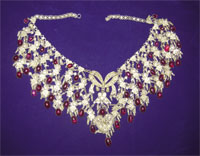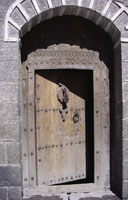
Five Yemeni handcrafts are losing their identity (Part 2) [Archives:2008/1128/Culture]
February 11 2008
 |
 |
 |
For Yemen Times
Many traditional Yemeni handcrafts are in great demand due to their elegant style and the high quality of raw materials used. However, many more have disappeared completely or are in danger of losing their identity because each craft demands a set of specialized skills and raw materials of high quality. Because Yemen's raw materials are exported outside the country, their prices have increased.
A December 2007 field study attempting to catalog and document traditional handcrafts in the Old City of Sana'a found that while 28 percent the area's residents are craftsmen, most have discontinued such work for several reasons, most importantly, low income and more cheaply imported similar handcrafts.
A national team from Yemen's General Organization of Antiquities, Museums and Manuscripts, under the auspices of the Social Fund for Development, worked for a year to document all Yemeni handcrafts in the Old City of Sana'a, which are an important part of the nation's cultural heritage created by various civilizations throughout centuries of history. Thus, they are experiences handed down from generation to generation.
The seven-member research team consisted of: Amat Al-Bari Al-Adi, Amat Al-Razzaq Jahaf, Abdulqadir Al-Shaibani, Zaid Al-Faqih, Ibrahim Al-Hadid and Abdulaziz Ibrahim.
Team leader Al-Adi believes that imported handcrafts affect Yemeni handcrafts. According to initial team estimates, Jahaf says only 35 percent of such handcrafts exist today in the Old City, which threatens craftsmen with losing their livelihoods.
Further, because raw materials have become rare, many craftsmen depend on exported raw materials, which affects the quality of the handcrafts.
Al-Adi explained that in order to reach those outcomes, the team conducted its research in four stages, the first of which was a survey to determine the number of handcrafts, craftsmen and handcraft shops. The survey involved the type of handcraft, the number of shops selling it and the name of the street where it's located.
The team's leader continued, “Next, we analyzed the results and used them to apply stage two,” which was collecting the historical background of the 27 Yemeni handcrafts.
“Stage three was preparing a meeting of specialists in this field to study what we did and to continue our work of cataloging the handcrafts,” Al-Adi noted. The final stage was a comprehensive field study wherein the team surveyed and documented Old City handcrafts by photographing and recording everything, even the songs the craftsmen sing while they work.
Handcrafts losing their identity
Five out of 27 Yemeni handcrafts are threatened with losing their identity and those are the making of the jambiyya and its belt, traditional carpentry, Yemeni agate or onyx polishing and shaping, and silver making.
Jambiyya
Yemen's jambiyya consists of its handle, al-mibsam and al-nasla (the dagger itself).
Considered the most important part, jambiyya handles are made from the horns of animals such as cows, goats, rhinoceros and giraffes. With two types of cow horns, red and white, they are the cheapest while the best and most expensive jambiyya handles are made of rhinoceros horns.
Al-mibsam is an ornamental band of pure silver. If a jambiyya is valuable, the band is gilded. The meeting point between the handle and al-nasla, al-mibsam is affixed horizontally to the bottom of the handle. Al-nasla is the dagger itself made of iron.
Mohammed Al-Uzairi, an important source for the researchers, notes that his family passed down this traditional handcraft from generation to generation; therefore, their name has become a trademark for good jambiyyas.
“There are jambiyyas that are called Al-Uzairi, Al-Saifani and Al-Asadi,” Jahaf adds.
Zaid Al-Gadhba, a 50-year-old craftsman making al-nasla in the Old City of Sana'a, suggests that the craft may be 1,000 years old. He makes three types of nasal (the plural of al-nasla): Banuz, Dhamaria and Sana'ania.
Nabeel Kaidama, a 40-year-old craftsman specialized in carving jambiyya handles, says that while Al-Uzairi is the most famous type of jambiyya, numerous types of janaby [plural for jambiyya] have emerged, adding that, “Craftsmen used to make them out of elephant tusks, camel hoofs, marble and Yemeni agate or onyx.”
When laws against hunting rhinoceros began affecting the jambiyya industry, most craftsmen began using cow horns, which are called al-kark.
According to Al-Uzairi, the only valuable jambiyyas are those ancient ones whose owners were compelled to sell them because of their particular circumstances. The price of an ancient jambiyya may be as much as $12,000.
No one dares to steal such a precious jambiyya because a thief neither can wear it nor sell it. Because the important janaby are well-known, particularly to specialists in the craft, anyone attempting to sell it will be discovered immediately and even if he does find someone to buy it, the buyer will be afraid to wear it because, as Al-Uzairi notes, “Such types are very distinctive.”
The jambiyya belt
The importance of a jambiyya's belt lies in the importance of the jambiyya itself. “There's no information about how the various types of jambiyya belts originated,” Jahaf says, “But according to my research, I believe they simply developed from the ancient sword belts made of gold or silver.”
Mohammed Jazem, a specialist in this handcraft, explains that there were two types of ancient sword belts – hammala and hayasa – however, they have since vanished because people wear today janbyyia instead of the ancient sword. There are only two or three craftsmen in the Old City of Sana'a, but no one requests.
The most common type of the belt nowadays is a different variation of those belts. It is a piece of hand-embroidered white cloth affixed to a leather belt, Jahaf notes.
Traditional carpentry
While the wood used in Sana'a varies, Al-Tanab is the best because it's strong enough to withstand both sunlight and wetness. Additionally, woodworms can't destroy doors made of this type of wood or eat it for hundreds of years.
The type of wood used to make locks, Al-Ghudhar, is different because although it's light, it's hard. Further, Al-Humr and Al-Barqouq wood are used in furniture making.
As Jahaf points out, “We've documented many traditional wood works, including numerous types of doors, windows, mashrabiyya (bay windows) and boxes.”
Yemeni agate or onyx
Additionally, she says, “We've documented the traditional way of shaping and polishing Yemeni onyx.”
Muslih Al-Hadad and Mohammed Abu Talib are the Old City's most famous craftsmen who informed the research team about the traditional way of shaping and polishing Yemeni agate or onyx. According to them, the traditional method involves preparing the raw agate in three steps: al-taqsiya, al-ramla and al-tashdeef; these steps for shaping the raw agate. In these steps, craftsmen harden the raw material and then cut the agate into a specific form.
Stage two is to polish the agate through four steps: al-tashweeb, al-qirab, al-tisi and al-talmee.
However, according to Al-Hadad, a trainer at the National Center for Handcrafts Development, a new way of shaping agates is to harden the raw material in two machines called Al-Jalkh and Dabasha.
Stones are placed in a specialized fireplace within an iron vessel. The agates are cut into several sizes and the Jalkh machine is used to sharpen them and make the patterns within them clearer. The final step is to polish the stones in the Dabasha machine, which resembles a plastic jar, Jahaf explains.
Silver making
Yemeni silver jewelry has a long-standing tradition and has enjoyed great popularity, not only in the Arab world, but worldwide. According to Jahaf, Yemeni silver has two distinctive cultural characteristics, the first one being the Yemeni name for silver itself, mikhlas. Even silver shops are called al-mikhlas.
“I asked one silversmith the meaning of this word and when exactly it was used. He told me it comes from the word 'sincerity' because those working at any job, but particularly in silver, must be accurate in order to create pure silver,” Jahaf said.
The second distinguishing characteristic is that Yemeni silver is free of Qur'anic verses. The reason for this, according to the Yemeni team's field study, is that since the 18th century, Yemeni silversmiths have been Jewish.
“They may have avoided inscribing Qur'anic verses on their work because it's not their religion or possibly out of respect because it's forbidden to wear something with the name of God in a bathroom,” Jahaf offered.
Approximately 19 silversmiths lived in the Old City of Sana'a in 1960, with Jahaf explaining that the numbers decreased when Yemeni Jews emigrated to Palestine between 1948 and 1950.
“After that, Yemeni Jews trained other Yemenis in this handcraft and many excelled at it, but the most famous ones today are Mohammed Al-Ramush and Mohammed Al-Faqih,” Jahaf noted.
However, people began abandoning traditional silver jewelry for many reasons. Women, particularly those who worked, preferred wearing the lighter gold jewelry. Thus, gold jewelry took over the status of silver because of its cost. Although silver jewelry is expensive to buy, it is sold cheaply.
“Exactly when this handcraft changed and lost its Yemeni identity remains vague, but a significant change has occurred regarding the status of silver in Yemen, thereby affecting its forms, the raw materials and machinery used. In the past, jewelry was handmade, which made it more accurate and beautiful,” Jahaf stated.
“We can't pinpoint the exact time, but, according to our study, a major change occurred in this handcraft when the National Center for Protecting Traditional Handcrafts opened.
“The center intended to preserve Yemeni heritage, particularly silversmithing, but the project failed because the center's manager was interested in making new forms of jewelry instead of traditional ones. Moreover, he used poor quality raw materials,” Jahaf added.
While there are four types of silver making in Yemen, depending on the region, the Yemeni team's study was interested only in those types produced in the Old City of Sana'a.
“The first type, Al-Bawsani, is the best because it's more accurate and the silver is more pure. The second type is Al-Badihi and it enjoys second status in terms of purity and accuracy, while the third type is Al-Mansouri, followed by Al-Shadadi,” Jahaf explained.
Further, the names of ancient silver jewelry are different than more recent silver jewelry.
“Necklace was called al-lubaat and there were many types such as lubat abu tair, lubat abu wajhain, lubat mazamir, al-miasabah, al-mashaqer and al-asawer. There also were al-tafiyaat (bracelets) such as al-tafiya Al-Bawsaniya and Al-Mansouriya. Other types of cuffed bracelets are masca and shumailiyya,” Jahaf noted.
She concluded, “We also documented numerous types of rings, belts and ta'aeedh, which is something hung to protect one from 'the evil eye'.”
——
[archive-e:1128-v:15-y:2008-d:2008-02-11-p:culture]


